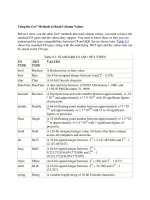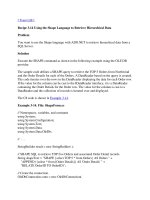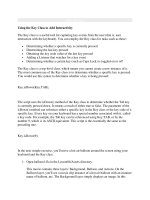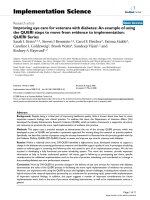Tarot journaling using the celtic cross to unveil your hidden story
Bạn đang xem bản rút gọn của tài liệu. Xem và tải ngay bản đầy đủ của tài liệu tại đây (1.56 MB, 236 trang )
TableofContents
TitlePage
CopyrightPage
Epigraph
ACautionaryNote
Dedication
Foreword
Preface:ReadingandWriting
HowtoUseThisBook
TheBenefitsofTarotJournaling
SignificantDecisions
Chapter1-WhatCoversYou
AtmosphereandInfluences
Location,Location,Location
SacredSpace
RitualandRoutine
StartingPoints
ShortcutsandAbbreviations
ReversedCards
Checklists
FillintheBlanks
Chapter2-WhatCrassesYou
JournalingObstaclesandStumblingBlocks
FearofCommitment
Writer’sBlock
PerformanceAnxiety
TimeManagement
Procrastination
BadCards
Negativity
CriticalOpinions
GetGuidance
Twenty-TwoTipsforTiredJournals
Chapter3-WhatCrownsYou
PersonalPrivacyandtheEthicsofKeepingaTarotJournal
WritingAboutReadings
ReadingAboutOthers
PrivateMatters
SharewithCare
ALegalBrief
FinalArrangements
Chapter4-WhatGroundsYou
HowtoUseaTarotJournalasaFoundationforYourWorkwiththe
Cards
CardInterpretations
Cluster
CardDescriptions
OneCardaDay
Correspondences
SymbolicTouches
SpreadsandLayouts
CharacterSketches
GoInsidetheCards
AGuidetoGuidedMeditation
TheMeditation
JournalingPrompts
FocusedMeditation
Dialogues
Lists
TimedWriting
CreativeWriting
ArtisticPursuits
SweetDreams
Chapter5-WhatLiesBehindYou
HowtoRewriteHistoryinthePagesofYourJournal
HistoryintheMaking
StudytheFool’sJourney
YourOwnFool’sJourney
PersonalStories
SadderbutWiser
ThePersonYouUsedtoBe
RewriteHistory
Chapter6-WhatLiesBeforeYou
HowtoUseYourTarotJournaltoDesignYourFuture
SealtheDeal
MakePlans
Brainstorm
BacktotheFuture
SpecialRequests
SpellItOut
Chapter7-YourSelf
WhoDoYouThinkYouAre?
WorldsofExperience
YourSpiritualSelf
YourEmotionalSelf
YourIntellectualSelf
YourPhysicalSelf
BirthCardsandYearCards
FacetsoftheJewel
RolePlay
MasksofPersonality
Chapter8-YourHouse
JournalingaboutFamilyandFriends
TheRoyalFamily
ForgetMeNot
Chapter9-YourHopesandFears
PlumbingtheDepthsandClimbingNewHeights
HopeSpringsEternal
FearFactors
Chapter10-WhatWillCome
ForetellingtheFuture
FortunetellingandtheTarot
TypesofPsychicAbility
GuidelinesforPsychicDevelopment
DocumentingYourSuccess
APPENDIXI-WritingPrompts
APPENDIXII-MinorArcanaCorrespondences
APPENDIXIII-HowtoConductaTarotCardReading
APPENDIXIV-TarotCardKeywords
APPENDIXV-FormsandTemplates
AbouttheAuthor
CorrineKennerspecializesinbringingmetaphysicalsubjectsdowntoearth.Her
workonthetarotiswidelypublished,andhertarotclassesandworkshopsare
perennialfavoritesamongstudentsintheMidwest.
Corrineisacertifiedtarotmaster,andshehasstudiedtarotundertheauspices
oftheTarotSchoolofNewYork,theWanlessTarotInstitute,andBuildersofthe
Adytum.Shealsoholdsabachelor’sdegreeinphilosophyfromCaliforniaState
University,LongBeach.
Corrine has lived in Brazil, Los Angeles, and the Twin Cities of Minnesota.
ShenowlivesintheMidwestwithherhusband,DanHoron,andherdaughters,
Katherine, Emily, and Julia. In her everyday life, she is the vice president and
communicationsdirectorofCadgraphicsIncorporated,asoftwarecompanythat
specializesinfirealarmandsecuritysystems.
CorrineistheauthorofLlewellyn’sTallDarkStranger,aguidetousingtarot
cardsforromance,aswellasCrystalsforBeginners.ShewroteTheEpicurean
Tarot, published by U.S. Games Systems, Inc., and she was the creator of
Llewellyn’sTarotCalendar.Aformernewspaperreporterandmagazineeditor,
CorrinewasalsotheeditorofLlewellyn’spopularAstrologicalCalendar,Daily
PlanetaryGuide, and Sun Sign Book, as well as an anthology of supernatural
accountscalledStrangeButTrue.
TarotJournaling:UsingtheCelticCrosstoUnveilYourHiddenStory©2006byCorrineKenner.Allrights
reserved.Nopartofthisbookmaybeusedorreproducedinanymannerwhatsoever,includingInternet
usage,withoutwrittenpermissionfromLlewellynPublicationsexceptinthecaseofbriefquotations
embodiedincriticalarticlesandreviews.
FIRSTEDITION
FirstPrinting,2006
BookdesignandeditingbyRebeccaZins
CoverdesignbyLisaNovak
Tarotcardsonpage90fromUniversalTarotby
RobertoDeAngelis;usedbypermissionofLoScarabeo
LlewellynisaregisteredtrademarkofLlewellynWorldwide,Ltd.
LibraryofCongressCataloging-in-PublicationDataKenner,Corrine,1964-.
Tarotjournaling:usingtheCelticcrosstounveilyourhiddenstory/CorrineKenner.—1sted.
p.cm.
Includesbibliographicalreferences(p.).
ISBN-13:978-0-7387-0643-6ISBN-10:0-7387-0643-4
1.Tarot.2.Diaries—Authorship—Miscellanea.I.Title.
BF1879.T2K472006
133.3’2424—dc22
2005044540
LlewellynWorldwidedoesnotparticipatein,endorse,orhaveanyauthorityorresponsibilityconcerning
privatebusinesstransactionsbetweenourauthorsandthepublic.
Allmailaddressedtotheauthorisforwardedbutthepublishercannot,unlessspecificallyinstructedbythe
author,giveoutanaddressorphonenumber.
AnyInternetreferencescontainedinthisworkarecurrentatpublicationtime,butthepublishercannot
guaranteethataspecificlocationwillcontinuetobemaintained.Pleaserefertothepublisher’swebsitefor
linkstoauthors’websitesandothersources.
LlewellynPublications
ADivisionofLlewellynWorldwide,Ltd.
2143WooddaleDrive,Dept.0-7387-0643-4
Woodbury,MN55125-2989
www.llewellyn.com
PrintedintheUnitedStatesofAmerica
Eachnewdayisablankpageinthediaryofyourlife.Thesecretofsuccessis
inturningthatdiaryintothebeststoryyoupossiblycan.
—DOUGLASPAGELS
ACautionaryNote
Keeping a tarot journal can be therapeutic, but it isn’t therapy. This book was
writtenasameanstohelpyoulearnmoreaboutyourself,learnmoreabouttarot
cards, and have fun. It was not designed to replace the services of a licensed
physician or counselor. If you find that the suggestions make you feel
uncontrollably weepy, giggly, angry, or outspoken, you may want to seek
professionalhelp—orstartoverwithanewjournal.
The author and the publisher assume no responsibility for any adverse
consequences that may result from the use of this guide, including but not
limitedtowriter’scramp,badhandwriting,oracompulsiontobuyblankbooks,
tarotdecks,andpens.
Dedication
To myoldArtist’sWay group in St. Paul: Karen Failes, Lynn Johnson, Kim
Labuz,LindaNicosia,andespeciallyMaryLynch.
To my tarot friends from the Readers Studio in New York: Wald and Ruth
Ann Amberstone, Kim Arnold, Chris Asselin, Joanna Powell Colbert, Jeffrey
Elliott, Mark McElroy, Elinor Greenberg, Carolyn Guss, Debbie Lake, Rachel
Nguyen,KevinQuigley,GinaThies,JamesWells,DianeWilkes,andespecially
myroommate,CherylSigler.
Tothepeoplewhoencouragedmeandhelpedteachmehowtowrite:Sister
MaryMargaret,myseventh-andeighth-gradeEnglishteacher;SamJohnson,my
high school journalism instructor; and Catherine Gaugh, my editor at The
OrangeCountyRegister.
Andofcourse,tomyhusband,DanHoron;myparents,WayneandCarolyn
Kenner;andmydaughters,Katherine,Emily,andJulia.
Foreword
Tarotandpsychotherapyarebecomingmorealikeeveryday.Althoughmost
ofusstarttarotbecausewewanttolearntheartofdivination,afterlearningthe
basicsmanyofusturntothecardsinordertolearnmoreaboutourselves.Tarot
journalingisanoutgrowthofthatdesire.Itallowsustouseourfascinationwith
the cards as a vehicle for moving beyond our own surface identity into deeper
andmorehiddenpartsofourpersonality.
Asapsychotherapist,Ioftensuggestthatmyclientskeepatherapyjournalas
a way of keeping them involved in the therapy process between sessions. I
encouragethemtokeeptrackoftheirdreams,writeabouttheirreactionstotheir
therapy sessions, and jot down any new thoughts and observations that they
would like to discuss. Eventually it becomes an emotional autobiography that
chroniclestheirdeepestandmostpersonalreactionstotheireverydaylife.
One of the interesting facts about these journals is that many of my clients
who successfully keep therapy journals had previously seen themselves as
writing failures. Some even had writing phobias that interfered with them
turninginpapersincollege.IcouldidentifywiththeseproblemsbecauseIhad
experiencedsimilardifficultiesduringcollegemyself.
Despitemylatersuccessinkeepingdreamandtarotjournals,Iinitiallymade
a number of failed attempts at keeping a diary. When faced with a blank page
andthemissionofsayingsomethingimportantaboutmylifeonadailybasis,I
could not do it. I found it too difficult to access my feelings and get beyond
keeping a superficial record of my daily activities. I also was inhibited by my
fear that if I wrote truthfully, my parents, roommate, or boyfriend of the time
wouldpeek.
As I tried to understand what had changed for my clients and myself that
allowed us to keep dream and therapy journals successfully, I realized that the
natureofthesejournalsfreesusfromthreethingsthatoftengetintheway:one,
wenolongerhadtodecidewhattowriteabout;two,theassignedthemehelpsus
organizeourthoughts;andthree,weknowthatthequalityofourwritingwillnot
bejudged—wecanjotdownafewideas,writeendlessrun-onsentences,andit
doesnotmatter.
Tarot journals share exactly the same virtues. The tarot journal revolves
aroundtarotcards:whattheymean,whattheylooklike,ourreactionstothem,
and exercises involving them. This saves us from looking at a blank page and
wonderingwhattowriteabout.Inaddition,weknowfromthebeginningthatthe
journalisforourselvesand,asCorrinemakesabundantlyclearinthisbook,we
arefreetodoanythingthatwewishwithit.Wecanwriteiniteverydayoronly
occasionally.Itcanbedecoratedorplain.Thereisnorightwayorwrongwayof
doingit.Whatthismeansisthattarotjournals,inadditiontoteachingthetarot
enthusiastmoreabouttarot,allowmanyofustoexperienceforthefirsttimethe
pleasuresofjournaling.
Thisnewfreedomtowritecanbeaheadyexperience.Iwentfromkeepingno
journalsinhighschoolandcollegeto,atlastcount,keepingfivedifferenttypes
of tarot journals.Ibegan mytarot studiesbyplacingacardin themiddle ofa
blankjournalpageandwritingallmyassociationstoit.Next,asIprogressed,I
beganajournalinwhichIrecordedeveryreadingthatIdidandwhichbooksI
usedasreferences.AsIgrewmoreconfidentaboutmyreadingskill,Iconvinced
myhusbandthatheshouldjoinmeinchoosingacardadayforeachofus,andI
recorded my observations about how the card related to what happened to us
duringtheday.Now,wheneverIreadaninterestingbookontarotorbeginanew
tarot course, I keep a journal at my side to jot down new information, my
reactions,andarecordoftarotexercises.(MaryGreerandTomLittle’sbookon
courtcards,UnderstandingtheTarotCourt,inspiredmymostrecentjournalof
thiskind.)
Thereisanotherimportantwaythattarotjournalingresemblespsychotherapy.
It helps us access parts of ourselves that may be outside our everyday
consciousness. The late Milton H. Erickson, MD, who was arguably the most
effective and innovative hypnotherapist of all time, often said that we already
haveallthetoolsthatwewilleverneedinsideus;hypnosisjusthelpsusaccess
them. From this point of view, the tarot deck is an illustrated compilation of
potential tools. All seventy-eight tarot cards represent aspects of the self that
exist inside each of us as potential behaviors, talents, and attitudes. Tarot
journalinggivesusawaytoaccessthemandintegratethemintoourconscious
senseofwhoweare.
ThisisverysimilartowhatIbelieveaboutdreams.AsaGestalttherapist,I
believethatallthecharactersthatpopulateourdreams,nomatterhowadmirable
orrepugnant,representpartsofus.Ifwewanttogettoknowourrealselfbetter,
wehavetoacknowledgeandgettoknowthem.Doingsohelpsusexpandand
deepenoursenseofwhowereallyareandmakesusmoreintegratedandthreedimensional.
Manyofusfirstencountertheseotherpart-selvesindreams.Sometimesthey
are the monsters that we are fleeing from in nightmares—what Carl Gustav
Jung, the great Swiss analyst, called our “shadow” side. Other times they are
more benign figures that are based on people we know from everyday life.
Whethergood,bad,orneutral,onadeeperleveltheyaresymbolsthatrepresent
partsofus.However,itishardtocaptureandexamineourdreams.Bythetime
weawaken,importantdetailsarealreadylost.
Unlikedreams,tarothasthevirtueofbeingamirrorthatwecanholdinour
handsandlookatwheneverwewant.Allwehavetodoinordertostudyoneof
ourpart-selvesistoremovethatcardfromourdeckandputitdowninfrontof
us.Ifwewishto,wecanuseourmind’sunconsciousresponsestothesymbols
inthecardtoconsciouslyevokeinourselvesthequalitiesofthatcard.Thecard,
inthatcase,becomesapictureofanintention.
Letmegiveyouanexample.Imaginethatyouaretryingtodecidewhattype
oftarotjournaltokeep.Youdrawacardfromyourdeckforguidanceandget
the Eight of Cups from the Rider-Waite-Smith deck. As you contemplate the
card, you decide that you will let the number of the card direct you to the
correspondingchapterinthisbook,chapter8:“YourHouse,”andyoudecideto
chooseyourjournalfromoneofthetypesdescribedinthatchapter.Thecard’s
suit,cups,whichrepresentstheelementofwater,suggeststoyouthatyoushould
takeanimaginativeandemotionalapproachtoyourjournal.
You gaze at the red-cloaked figure in the Eight of Cups, who appears to be
settingoutalonetosearchforhisorherheart’sdesire,andyouallowthisimage
toworkonyourunconsciousmindandactivatesomethingwithinyou.TheEight
ofCupsthenbecomesapictureofyourintentiontogoonyourownjourneyand
find within this tarot journal something deeply meaningful and fulfilling for
yourself, something new that you don’t already have. As you look at the card
andthinkofthethemeoffamilyandfriends,youmightaskyourself:Wheream
I going? What kind of home did I come from? What type of friends am I
seeking?WhatamIwillingtoleavebehind?Ifyouchooseto,youcouldfurther
deepen the card’s association with your new journal by making a copy of the
cardandattachingittothejournal’scoverorfirstpage.Younowhaveinvoked
itsspiritasyourguide.
The ease with whichtarotcanbeusedtohelpusmove outofour everyday
consciousnessintosomethingmoreprofoundiscontributingtothephenomenal
growth of tarot today. When we combine the magic of tarot with the
introspectivenatureofkeepingajournal,wefindourselveswithapowerfultool
for personal growth. Whenever we begin a tarot journal, we are knowingly or
unknowinglycommittingtostudyingandevolvingourselves.
ELINORGREENBERG,ph.d.,isalicensedpsychologistandcertified
professionaltarotreaderwhohasbeenpracticingpsychotherapyfor
overthirtyyears.Dr.GreenbergispsychologyconsultanttoTheTarot
School,theholderofaSecondDegreefromTheTarotSchool,andis
currentlyworkingonandwritingabouthowtointegratetarotwith
psychotherapy.Herarticle“TarotCounseling”willappearin
Llewellyn’sTarotReader2007.
Preface:ReadingandWriting
Irememberthemomentwhenpsychologist
JaneAlexanderStewartandIlaiddownthe
twenty-twooversizedcardsoftheMajorArcanaofthe
tarot,sayingtothosewhohadassembledwithus,
“Thesearethestationsofthejourney.”Suddenly,
wewerebothinsacredspaceandinstory...
—DEENAMETZGER,
WritingforYourLife
Ifyouhaveeverhadatarotcardreading—orifyouhaveeverreadthecards
forsomebodyelse—youknowthepowerandthedramaofthecards.
Thinkbacktoyourtimeatthetarotreader’stable.Asthereadershuffledthe
deck, you might have caught a glimpse of a recognizable image or two: the
Lovers,perhaps,ortheWheelofFortune.Eachglanceheightenedthesuspense,
andhintedatthetalesandthetruthsthatwereabouttounfold.
As the reading began, each facet of your life came sharply into focus. Your
past, present, and future were laid out in front of you. Your foundation was
displayedatyourfeet;yourhighestidealswerepoiseddirectlyoverhead.Your
self-image, your public image, and your hopes and fears were all there to be
revealed.Didyouembracetheoutcomeorseekanewcourseforthefuture?
People read tarot cards for a variety of reasons. Some are captivated by the
illustrations.Somearefascinatedbythemythsandlegendsassociatedwitheach
card.Somewanttorelivethepast,whileotherswanttoenjoyandexperiencethe
presentmorefully.Andeveryonewantstoprepareforthefuture.
Thosearethesamereasonsthatmillionsofpeopleturntodiariesandjournals.
Tarotcardsandjournalsaremagicaltoolsthatcanhelpussparkourcreativity.
Both can help us develop our intuition and express our visions, hopes, and
dreams.Bothfocusonthepatternsofeverydayexperiencesandone’splaceina
larger universe. Both are primarily instruments of the present moment, with a
degreeofreflectionandpredictionthrowninforgoodmeasure.Bothcanhelpus
integrateourexperiencesandprovidewideavenuesforreflection,introspection,
andself-development.
Infact,theissuesthatmostpeoplebringtoatarotreadingarethesameissues
they bring to theirjournals:concerns aboutthepast,qualmsaboutthepresent,
and questions about the future. They struggle with the desire to please
themselvesversustheirneedtopleaseothers.Theyhopeforthefuture—andfear
theunknown.
Ultimately,peoplewhoreadtarotcardsandpeoplewhokeepjournalsareboth
participating in a creative process. They are engaged in acts of creation, of
storytelling.Theyareactivelyweavingthefabricoftheirlives,spinningyarns,
putting their own stories into context, and weaving together the past, present,
andfuture.Alltold,theyareonaquestforself-discovery.
Thetarotisanaturalpartnerinthatquest.Tarotcardsprovideaready-made
frameworkforanalysisandcontemplation.Thestructureofthedeckisholistic.
Thesymbolsoneachcardreflecttheancientmythsandlegendsthatshapeour
perceptions of the world, as well as the dramas of everyday existence. And
because the tarot is firmly rooted in Western culture and tradition—including
mythology, astrology, numerology, and the Bible—the cards are accessible to
anyonefamiliarwithmodernlife.
Whenyoucombinetheuseofthetarotwithajournal,youcreateapowerful
vehicle for growth and change. Adding tarot cards to a journaling routine can
help you see yourself clearly, recognize obstacles, overcome barriers, express
yourconcerns,andmakethemostofyourgiftsandtalents.Thetarotisanideal
tool forexploring your inner world,and thetarotjournalis an idealvehicle to
houseyourrecordofyourtravels.
By incorporating tarot cards in your journal, you can have a predesigned
templateforcontemplatingyourexistence.Throughthecards,youcanexplore
both the larger themes of the human experience and the variations of your
everydaylife.
Ifyoucometothisbookasajournaler,Ihopeyouwillbeinspiredtofinda
deckoftarotcardsandstartaddingthemtoyourjournalingpractice.Evenifyou
don’t think of yourself as a tarot reader, the cards will help you bridge the
communication gap between your conscious and unconscious minds, and
providearichsourceofideasandinspirationforyourjournals.Thecardswill
guide you into extensive, deep, rich, and meaningful journeys—and more
rewardingjournaling.
Ifyoucometothisbookasatarotcardreader,Ihopeyouwillbeinspiredto
startajournaltocomplementyourworkwiththecards.Atarotjournalwillhelp
you personalize the cards, master the structure and symbolism of the deck,
developarapportwiththearchetypesofthetarot,andaccessyourintuition.By
combiningtarotandjournaling,youcanmakethecardsworkbetterforyou.
Ineithercase,Ihavenodoubtthatyouwillimmediatelyfeelathomewiththe
conceptsandsuggestionsyouareabouttodiscover—andthatyoucancreatea
tarotjournalthatwillbecomeapowerfultoolforreflection,growth,andchange.
Whether you want to access your higher self, discover ancient wisdom, or
developyourintuition,atarotjournalwillhelpyoumapyourjourneyalongboth
theinnerandouterpathwaysofyourexistence.
Enjoythetrip—anddon’tforgettowrite!
CorrineKenner
HowtoUseThisBook
In1910,ametaphysiciannamedArthurEdwardWaitepublishedinstructions
foratarotspreadhecalled“AnAncientCelticMethodofDivination.”Itwasan
ingeniousspread—quick,versatile,andsoeasytousethatevenbeginningtarot
readerscouldgetspecificanswerstotheirquestions.
Since then, the Celtic Cross has become a perennial favorite among tarot
readers.Thespreadissopopular,infact,thatmostcanevenoverlookoneminor
detail:Waite’s“AncientCelticMethod”isn’tancient,anditisn’tCeltic,either.
(In fact, Waite’s secret society, the Order of the Golden Dawn, developed the
spreadfornewmembersofthegroupjustafewyearsbeforeheintroduceditto
thegeneralpublic.)
Nevertheless, for the last hundred years, the Celtic Cross has become a
mainstay of tarot readers, who like the fact that they can use it to explore any
subjectorconcern.Timeaftertime,theCelticCrosswillofferaclear,concise
overviewofpracticallyanysituation.
TheCelticCross
TheCelticCrossisaneleven-cardspread.Eachcardrepresentsaseparatefacet
of a single issue. The first card, the significator, represents the subject of the
reading.Thesecondcardillustratesthesituation.Thethirdcard,whichcrosses
thefirsttwo,describesanyconflictsoropposinginfluences.Additionalcardsin
thespreaddepictthefoundationoftheissue,therecentpast,thehighestideals,
the near future, self-image, public image, hopes and fears, and the most likely
outcomeofthecurrentsituation.
TheCelticCrossspreadiseasytomemorize.Afteryoulaythesignificatorat
thecenterofthespread—becauseitis,ofcourse,thecentralfocusofthereading
—youcanusethismnemonicchanttohelpyourememberwheretherestofthe
cardsgo:
1.Thiscoversyou.
2.Thiscrossesyou.
3.Thiscrownsyou.
4.Thisgroundsyou.
5.Thisisbehindyou.
6.Thisisbeforeyou.
7.Thisisyourself.
8.Thisisyourhouse.
9.Theseareyourhopesandfears.
10. This is what will come; this is the most likely outcome of your
currentpath.
The card positions aren’t arbitrary, and they didn’t come about by
coincidence.Infact,theCelticCrossspreadworkssowellbecauseitisdesigned
toreflectthewaywethinkandthewayweseetheworld.
Naturally,weallseetheworldfromourownpointofview—whichseems,to
each one of us, to be a central vantage point. We look back at our pasts and
forward to our futures. We find a foot-hold in whatever foundation we have
developed and we look up for guidance from our highest ideals. We picture
ourselvesinourownminds—andthenweseeotherpeoplereflectourwordsand
actionsbacktous.Finally,beforewedaretoconsiderthemostlikelyoutcomeof
our current existence, we pause to contemplate our fondest hopes and our
deepest,darkestfears.
THELAYOUTFORTHECELTICCROSSSPREAD.
In the years since its introduction, the Celtic Cross has served as the
framework for countless tarot readings. The Celtic Cross also serves as the
framework for this book. Each chapter of Tarot Journaling is based on the
information the Celtic Cross spread is designed to impart. This book is an
exampleofthefactthat,likeajournal,awrittenrecordcanbringatarotreading
tolife.
Youdon’tneedtoknowtheinsandoutsoftheCelticCrosstousethisbook.
Youdon’tneedtobeamasterofthetarotoralong-time,experiencedjournaler.
Youjustneedafewbasicsuppliesandawillingnesstoexploreyourlifewiththe
tarotasyourguide.
Ifyouarereadytostartshufflingandletthecardsfallwheretheymay,gather
yourcards,yourjournal,andapen,andyoucangetstarted.
TheBasics:ATarotTutorial!
Whileyoudon’tneedtobeatarotexperttousethisbook—ortocreateatarot
journal—your work will be easier if you understand the basic structure and
symbolismofthetarotdeck.
Thetarotisadeckofseventy-eightcardsdividedintotwosections:theMajor
ArcanaandtheMinorArcana.TheMinorArcanahasfoursuits.Eachsuithas
tennumberedcardsandfourcourtcards,muchlikeastandarddeckofplaying
cards.
While that might seem like a lot to comprehend, it’s actually an elegant
design.Eachcomponentfitsneatlyinsidetheonethatcomesbeforeit,likeaset
ofRussiannestingdolls.Individually,eachsectionofthedeckseemscomplete
inandofitself—untilyouopenitandfindthere’sanotherwholeworldtucked
neatlyinside.
What’smore,thestructureandthesymbolismofthetarotdeckisgroundedin
the real world. Because it reflects our shared experience as human beings, it’s
easiertounderstandthanyoumightthink.









